Sea Isle officials are hoping for sunny beach weather the rest of the summer and into the autumn shoulder season to boost business.
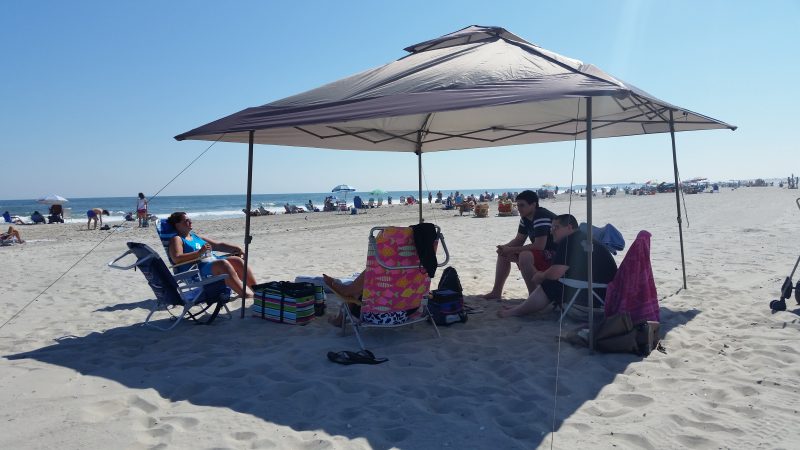 By Donald Wittkowski
Sea Isle City is going to have a serious discussion about beach etiquette.
Smoking on the beach, a new phenomenon called “tent-spreading” and the potentially dangerous holes dug in the sand by children will be the focus of a public hearing during City Council’s meeting on Tuesday.
The five-member Council, with the public’s help, will consider whether to ban or restrict those activities or simply maintain the status quo.
Council President Mary Tighe acknowledged that the governing body might not be ready to impose an outright ban, but she did stress that city officials will be looking for ways to address growing complaints about bad behavior on the beaches.
“I don’t know if the sentiment for banning is there yet,” she said.
For the time being, Tighe believes the best way to handle the complaints is to have government officials, the police department, the city’s beach patrol and the public kick around some ideas in advance of the 2018 summer vacation season.
By Donald Wittkowski
Sea Isle City is going to have a serious discussion about beach etiquette.
Smoking on the beach, a new phenomenon called “tent-spreading” and the potentially dangerous holes dug in the sand by children will be the focus of a public hearing during City Council’s meeting on Tuesday.
The five-member Council, with the public’s help, will consider whether to ban or restrict those activities or simply maintain the status quo.
Council President Mary Tighe acknowledged that the governing body might not be ready to impose an outright ban, but she did stress that city officials will be looking for ways to address growing complaints about bad behavior on the beaches.
“I don’t know if the sentiment for banning is there yet,” she said.
For the time being, Tighe believes the best way to handle the complaints is to have government officials, the police department, the city’s beach patrol and the public kick around some ideas in advance of the 2018 summer vacation season.
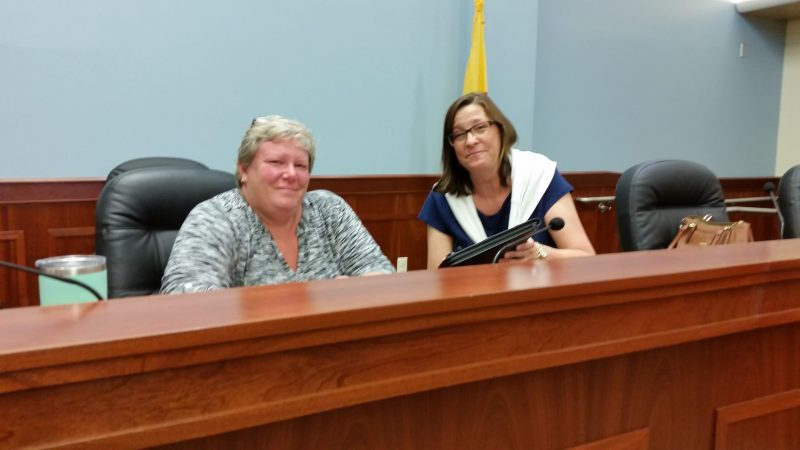 City Council President Mary Tighe, left, seated next to Sea Isle public relations director Katherine Custer, is looking for the public's help to solve complaints about beach behavior.
The public hearing, scheduled for 10 a.m. at City Hall, will also include a discussion about drinking on the beach and rowdy behavior. Drinking alcohol is already banned on the beaches, but local residents have complained to Council in recent weeks that the law is being blatantly ignored.
Police Chief Thomas D’Intino said officers go undercover in the summer, posing as regular beachgoers, to crack down on drinking and rowdy behavior.
While drinking on the beaches has been an age-old problem for seashore communities, there is a relatively new dilemma, called “tent-spreading” or “beach-spreading,” that is prompting debate in Sea Isle and elsewhere.
In short, some beachgoers are able to monopolize prime real estate by spreading out tents, canopies or cabanas on large swaths of sand just steps from the water. The tents also block out coveted views of the ocean, generating even more complaints.
Council members are expected to discuss the possibility of restricting tents and cabanas to certain areas of the beach to make sure they don’t take up too much space.
Already, Councilman Frank Edwardi has indicated he would not support banning tents or cabanas. He said they provide shelter from aggressive, food-snatching seagulls.
City Council President Mary Tighe, left, seated next to Sea Isle public relations director Katherine Custer, is looking for the public's help to solve complaints about beach behavior.
The public hearing, scheduled for 10 a.m. at City Hall, will also include a discussion about drinking on the beach and rowdy behavior. Drinking alcohol is already banned on the beaches, but local residents have complained to Council in recent weeks that the law is being blatantly ignored.
Police Chief Thomas D’Intino said officers go undercover in the summer, posing as regular beachgoers, to crack down on drinking and rowdy behavior.
While drinking on the beaches has been an age-old problem for seashore communities, there is a relatively new dilemma, called “tent-spreading” or “beach-spreading,” that is prompting debate in Sea Isle and elsewhere.
In short, some beachgoers are able to monopolize prime real estate by spreading out tents, canopies or cabanas on large swaths of sand just steps from the water. The tents also block out coveted views of the ocean, generating even more complaints.
Council members are expected to discuss the possibility of restricting tents and cabanas to certain areas of the beach to make sure they don’t take up too much space.
Already, Councilman Frank Edwardi has indicated he would not support banning tents or cabanas. He said they provide shelter from aggressive, food-snatching seagulls.
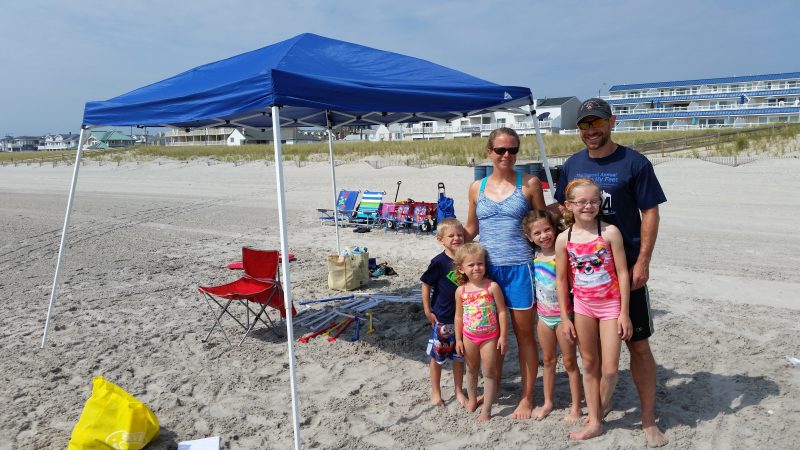 Deb and Joe Campbell, vacationers from Gettysburg, Pa., rely on a canopy as a sunshade for their four children.
During a late-summer vacation in Sea Isle, Joe and Deb Campbell kept their children, Hannah, 10, Samantha, 8, Jack, 6, and Madison, 4, safe from the sun’s glaring rays by tucking them underneath a 9-foot-by-9-foot canopy.
“The No. 1 reason is, it gives them protection from the sun,” Deb Campbell explained.
The Campbells, of Gettysburg, Pa., were vacationing in September. At that time, Sea Isle’s beaches were much less crowded than in the peak summer months, so the Campbells had plenty of room all to themselves.
Joe Campbell, however, said his family would be in favor of restricting canopies and cabanas to certain areas of the beach – perhaps farther back near the dunes – if that’s what it takes to create more space during the congested summer months.
“I would not be opposed to having them farther back on the beach, especially during the summer, when it gets very crowded,” he said. “I can appreciate the concerns about the canopies on the beach and the inconvenience they may cause.”
In addition to tent-spreading, the public hearing will also focus on whether there should be any restrictions for smoking on the beach and digging holes. Councilman William Kehner noted that cigar smoke, in particular, has been drawing objections from beachgoers.
Deep holes are often dug by children as part of their sand-sculpting, but they are not always covered up when they leave, creating a hazard for other beachgoers.
“Kids are there and digging holes. Then they walk away and someone else falls in them and breaks a leg,” Tighe said.
Instead of banning or restricting children from digging in the sand, Tighe suggested that perhaps the best approach would be an educational campaign to warn of the dangers of holes in the beach.
Deb and Joe Campbell, vacationers from Gettysburg, Pa., rely on a canopy as a sunshade for their four children.
During a late-summer vacation in Sea Isle, Joe and Deb Campbell kept their children, Hannah, 10, Samantha, 8, Jack, 6, and Madison, 4, safe from the sun’s glaring rays by tucking them underneath a 9-foot-by-9-foot canopy.
“The No. 1 reason is, it gives them protection from the sun,” Deb Campbell explained.
The Campbells, of Gettysburg, Pa., were vacationing in September. At that time, Sea Isle’s beaches were much less crowded than in the peak summer months, so the Campbells had plenty of room all to themselves.
Joe Campbell, however, said his family would be in favor of restricting canopies and cabanas to certain areas of the beach – perhaps farther back near the dunes – if that’s what it takes to create more space during the congested summer months.
“I would not be opposed to having them farther back on the beach, especially during the summer, when it gets very crowded,” he said. “I can appreciate the concerns about the canopies on the beach and the inconvenience they may cause.”
In addition to tent-spreading, the public hearing will also focus on whether there should be any restrictions for smoking on the beach and digging holes. Councilman William Kehner noted that cigar smoke, in particular, has been drawing objections from beachgoers.
Deep holes are often dug by children as part of their sand-sculpting, but they are not always covered up when they leave, creating a hazard for other beachgoers.
“Kids are there and digging holes. Then they walk away and someone else falls in them and breaks a leg,” Tighe said.
Instead of banning or restricting children from digging in the sand, Tighe suggested that perhaps the best approach would be an educational campaign to warn of the dangers of holes in the beach.
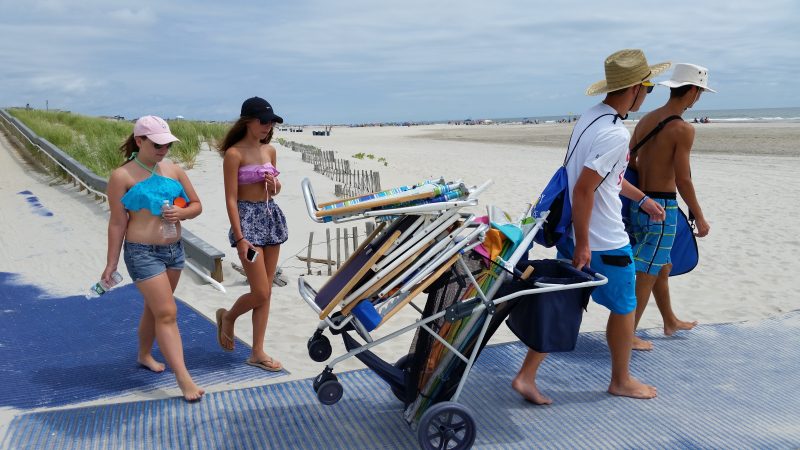 Beachgoers use a Mobi-Mat at 63rd Street for an easier walk across the powdery, deep sand.
In a final topic, city officials also plan to discuss whether Sea Isle should create more access to the beaches. One solution might be for the city to install more handicap-accessible walkways, called “Mobi-Mats,” to make it easier for elderly and disabled people to traverse the soft sand.
Sea Isle’s beaches were replenished in 2015 and 2016 with nearly 3 million cubic yards of new sand, creating a much wider shoreline spanning the entire 4.5-mile length of the barrier island.
Although the $40 million replenishment project has beautified the beachfront, a debate has started whether the city is doing enough to make the beaches more accessible to senior citizens and people with disabilities. Tighe pointed out that her 73-year-old mother, Marie Tighe, is among the local senior citizens who want better access to the beaches.
“I have lots of neighbors who are older. Even my mother yells at me, ‘I can’t get onto the beach in soft sand,’’’ Tighe said.
Ever since the replenishment project was completed, Sea Isle has concentrated on maintaining the gravel pathways that cross over the dunes to provide easy access to the beaches, city spokeswoman Katherine Custer said.
Sea Isle has Mobi-Mats on its handicap-accessible beaches at 32nd Street, 40
Beachgoers use a Mobi-Mat at 63rd Street for an easier walk across the powdery, deep sand.
In a final topic, city officials also plan to discuss whether Sea Isle should create more access to the beaches. One solution might be for the city to install more handicap-accessible walkways, called “Mobi-Mats,” to make it easier for elderly and disabled people to traverse the soft sand.
Sea Isle’s beaches were replenished in 2015 and 2016 with nearly 3 million cubic yards of new sand, creating a much wider shoreline spanning the entire 4.5-mile length of the barrier island.
Although the $40 million replenishment project has beautified the beachfront, a debate has started whether the city is doing enough to make the beaches more accessible to senior citizens and people with disabilities. Tighe pointed out that her 73-year-old mother, Marie Tighe, is among the local senior citizens who want better access to the beaches.
“I have lots of neighbors who are older. Even my mother yells at me, ‘I can’t get onto the beach in soft sand,’’’ Tighe said.
Ever since the replenishment project was completed, Sea Isle has concentrated on maintaining the gravel pathways that cross over the dunes to provide easy access to the beaches, city spokeswoman Katherine Custer said.
Sea Isle has Mobi-Mats on its handicap-accessible beaches at 32nd Street, 40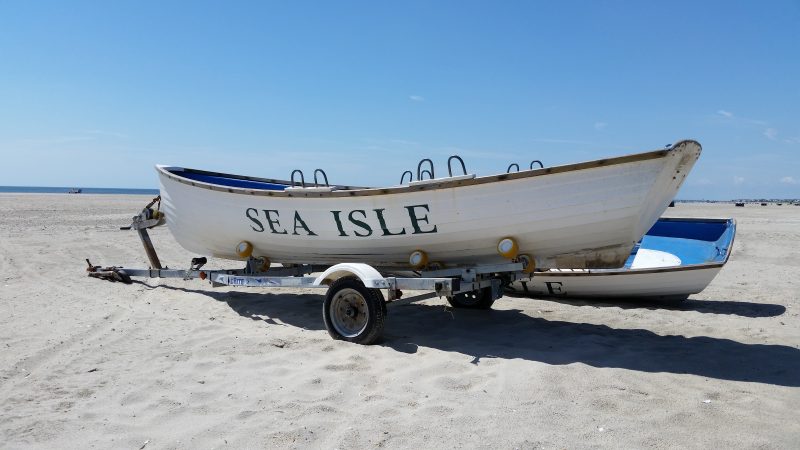 Sea Isle's $40 million beach replenishment project in 2015 and 2016 created deeper sand, making it more difficult for some people to walk across it.
Mobi-Mats, short for mobility mats, are hard, non-slip portable walkways that lie on top of the sand. They are especially convenient for people who are elderly, have disabilities or use wheelchairs.
Colored a distinctive sky blue, the mats are impossible to miss. At Sea Isle’s six handicap-accessible beaches, the Mobi-Mats average 70 feet long, providing an easier transition from the dune pathways to the sandy beaches.
Custer said it costs $2,700 for a 30-foot stretch of Mobi-Mat. With Sea Isle’s mats averaging 70 feet in length, that means it costs around $6,300 to have the walkways at each beach.
The public hearing Tuesday is expected to include a discussion on whether the city should buy more Mobi-Mats to make it easier for beachgoers to walk across the deep sand.
Sea Isle's $40 million beach replenishment project in 2015 and 2016 created deeper sand, making it more difficult for some people to walk across it.
Mobi-Mats, short for mobility mats, are hard, non-slip portable walkways that lie on top of the sand. They are especially convenient for people who are elderly, have disabilities or use wheelchairs.
Colored a distinctive sky blue, the mats are impossible to miss. At Sea Isle’s six handicap-accessible beaches, the Mobi-Mats average 70 feet long, providing an easier transition from the dune pathways to the sandy beaches.
Custer said it costs $2,700 for a 30-foot stretch of Mobi-Mat. With Sea Isle’s mats averaging 70 feet in length, that means it costs around $6,300 to have the walkways at each beach.
The public hearing Tuesday is expected to include a discussion on whether the city should buy more Mobi-Mats to make it easier for beachgoers to walk across the deep sand.